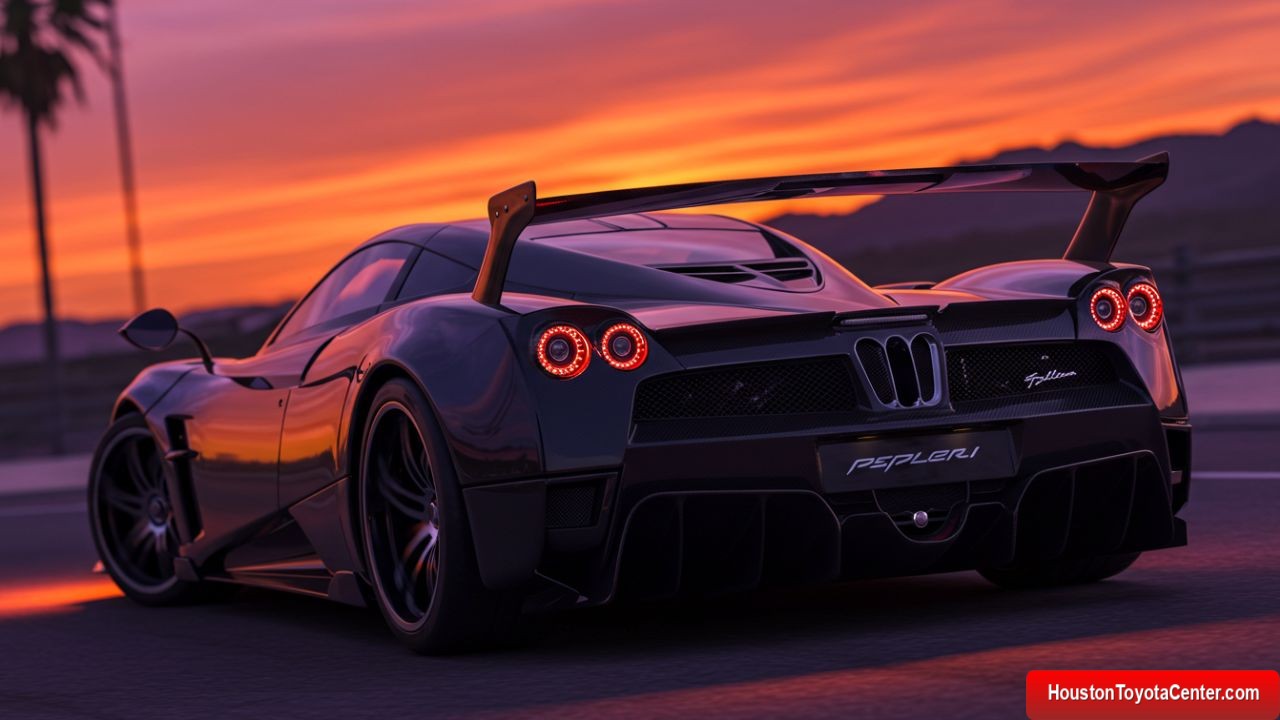In the world of hypercars, few names evoke the same reverence as Pagani. Founded by Horacio Pagani in 1992, this Italian marque has consistently redefined what it means to blend artistry with engineering excellence. Each Pagani model is not just a car; it’s a symphony of innovation, craftsmanship, and passion. From the iconic Zonda to the groundbreaking Huayra, every creation carries the DNA of its creator’s obsession with perfection.
Enter the Pagani Utopia , a name that encapsulates the brand’s relentless pursuit of automotive utopia—a vehicle where performance, design, and emotion converge seamlessly. Launched as the successor to the Huayra, the Utopia represents the pinnacle of Pagani’s technical prowess and artistic vision. But what truly sets this hypercar apart is its beating heart: the legendary V12 engine .
The V12 engine is more than just a powertrain for Pagani—it’s an embodiment of tradition, technology, and sheer audacity. In an era dominated by hybrid systems and electric propulsion, Pagani boldly champions internal combustion, proving that there’s still life—and immense potential—in the classic formula. This article delves into the soul of the Pagani Utopia, exploring how its V12 powerhouse drives not only the car but also the dreams of those who dare to experience it.
Chapter 1: The V12 Engine – A Timeless Marvel
Origins of the V12 Architecture
The V12 engine has long been synonymous with luxury, performance, and exclusivity. Its origins trace back to the early 20th century when manufacturers like Packard and Cadillac began experimenting with multi-cylinder configurations to achieve smoother operation and increased power. Over time, the V12 evolved into a symbol of prestige, gracing some of the most iconic vehicles ever built—from Ferrari’s racing machines to Rolls-Royce’s opulent sedans.
FREE: Quickly identify and understand problems with your vehicle 🚘
CLICK HEREFor Pagani, the choice of a V12 was never arbitrary. Horacio Pagani himself has often spoken about his admiration for the natural harmony produced by twelve cylinders firing in unison. Unlike smaller engines, which can feel frenetic or synthetic, the V12 delivers a deep, resonant growl that feels almost organic. It’s this visceral connection between driver and machine that makes the V12 so compelling.
Why Choose a V12 in 2023?
In today’s automotive landscape, electrification and downsizing dominate headlines. Automakers are increasingly turning to turbocharged four- and six-cylinder engines—or even abandoning internal combustion altogether—to meet stringent emissions regulations. Against this backdrop, Pagani’s decision to stick with a naturally aspirated V12 might seem counterintuitive. Yet, it aligns perfectly with the brand’s philosophy.
Pagani views the V12 not merely as a source of power but as a work of art. Every component, from the meticulously machined crankshaft to the hand-polished intake manifold, reflects Pagani’s commitment to craftsmanship. Moreover, the V12 offers unparalleled character—an intoxicating soundtrack and linear throttle response that no hybrid system can replicate. For enthusiasts who crave authenticity, the V12 remains unmatched.
Technical Specifications of the Pagani Utopia’s V12
At the core of the Pagani Utopia lies a bespoke V12 engine developed in collaboration with Mercedes-AMG. Dubbed the M158 Evo , this engine displaces 6.0 liters and produces a staggering 864 horsepower at 6,700 RPM and 1,100 Nm of torque at 2,000–5,000 RPM . These figures place the Utopia firmly in the realm of superlatives, yet they tell only part of the story.
What truly distinguishes the M158 Evo is its construction. Built entirely from lightweight materials such as titanium and carbon fiber, the engine weighs just 235 kilograms—a remarkable feat considering its size and output. Advanced technologies like dry-sump lubrication ensure optimal performance under extreme conditions, while twin exhaust outlets amplify the engine’s thunderous roar.
| Specification | Detail |
|---|---|
| Engine Type | Naturally Aspirated V12 |
| Displacement | 6.0 Liters |
| Power Output | 864 HP @ 6,700 RPM |
| Torque | 1,100 Nm @ 2,000–5,000 RPM |
| Weight | 235 kg |
| Redline | 7,200 RPM |
| Fuel System | Direct Injection |
These specifications underscore the Utopia’s position as one of the most advanced—and exhilarating—V12-powered cars on the planet.
Chapter 2: Engineering Excellence – How Pagani Pushes Boundaries
The Art of Lightweight Construction
One of Pagani’s guiding principles is the pursuit of minimal weight without compromising structural integrity. This ethos extends to every aspect of the Utopia’s design, including its engine bay. By utilizing exotic materials like Carbo-Titanium (a proprietary blend of carbon fiber and titanium), Pagani achieves a chassis that is both incredibly strong and exceptionally light.
The benefits of this approach are twofold. First, reduced mass enhances agility, allowing the Utopia to carve corners with surgical precision. Second, lighter components reduce strain on the engine, enabling it to operate more efficiently and deliver sustained peak performance. Even the smallest details, such as titanium fasteners and magnesium wheels, contribute to the overall weight savings.
Aerodynamics and Thermal Management
While raw power is crucial, managing airflow is equally important for a hypercar like the Utopia. Pagani’s engineers employed computational fluid dynamics (CFD) and wind tunnel testing to optimize the car’s aerodynamic profile. The result is a sleek silhouette that minimizes drag while maximizing downforce.
Equally impressive is the Utopia’s thermal management system. High-performance engines generate enormous heat, and ensuring adequate cooling is paramount. To address this challenge, Pagani incorporated large air intakes, strategically placed radiators, and specially designed ducts that channel air away from critical components. This ensures the V12 operates within its ideal temperature range, even during intense driving sessions.
Precision Handling and Driver Feedback
A powerful engine demands a chassis capable of translating that energy into motion. The Utopia features a state-of-the-art suspension system with electronically adjustable dampers, allowing drivers to tailor the ride quality to their preferences. Whether navigating tight mountain roads or cruising along coastal highways, the Utopia remains composed and communicative.
Power delivery is equally refined, thanks to a seven-speed automated manual transmission (AMT). Unlike traditional automatic gearboxes, the AMT provides lightning-fast shifts without sacrificing the tactile engagement of a manual setup. Paired with rear-wheel steering, the transmission ensures the Utopia responds instantly to driver inputs, creating a symbiotic relationship between man and machine.
Chapter 3: Design Philosophy – Where Form Meets Function
Sculpted Elegance
Every curve of the Pagani Utopia tells a story. Inspired by Renaissance architecture and aviation design, Horacio Pagani imbues his creations with a sense of timeless beauty. The Utopia’s flowing lines and intricate details are not purely aesthetic—they serve functional purposes as well.
For instance, the car’s gaping front grille channels air into the engine bay, while sculpted side skirts improve airflow around the body. Similarly, the rear diffuser accelerates air exiting the underside of the car, generating additional downforce. These elements combine to create a visual masterpiece that performs as well as it looks.
Interior Craftsmanship
Stepping inside the Utopia is akin to entering a sanctuary of luxury. Hand-stitched leather upholstery, polished aluminum accents, and exposed carbon fiber trim create an ambiance of refinement. Yet, functionality reigns supreme. Ergonomic controls, a digital instrument cluster, and customizable seating positions ensure the driver remains fully connected to the road.
One standout feature is the central tachometer, which dominates the dashboard. Its prominent placement emphasizes the importance of the V12 engine, serving as a constant reminder of the power at your fingertips. Even the steering wheel, crafted from lightweight alloys and wrapped in premium leather, feels like a piece of art.
Chapter 4: Performance Metrics – Unleashing the Beast
Acceleration and Top Speed
With 864 horsepower propelling a curb weight of just 1,280 kilograms, the Pagani Utopia boasts mind-bending performance figures. Zero to 100 km/h takes a mere 2.8 seconds , while the top speed exceeds 350 km/h . Such numbers place the Utopia among the fastest production cars in existence.
But straight-line speed is only half the equation. On winding roads, the Utopia’s balanced chassis and precise steering shine through. Corners that would fluster lesser vehicles become playgrounds for the Utopia, thanks to its near-perfect weight distribution and advanced traction control systems.
Track Capability
Although primarily designed for road use, the Utopia is no stranger to the racetrack. Optional packages include upgraded brakes, track-focused tires, and enhanced aerodynamic components. These modifications transform the Utopia into a formidable track weapon, capable of lapping circuits with ease.
Driving Experience
Ultimately, the Pagani Utopia is defined by the emotions it evokes. There’s something profoundly satisfying about piloting a car powered by a naturally aspirated V12. The instant throttle response, the crescendo of sound as the revs climb, and the sheer force pressing you into the seat—all these sensations coalesce into an unforgettable experience.
Conclusion: The Future of the V12 and Pagani’s Vision
As the automotive industry hurtles toward electrification, the future of the V12 engine hangs in the balance. Yet, brands like Pagani remind us why preservation matters. The V12 is more than a relic of the past; it’s a testament to human ingenuity and passion. With the Utopia, Pagani proves that tradition and innovation can coexist harmoniously.
Whether roaring down a highway or sitting silently in a garage, the Pagani Utopia stands as a monument to what’s possible when creativity meets engineering. It’s not just a car—it’s a dream realized, powered by the indomitable spirit of the V12.


Leave a Reply